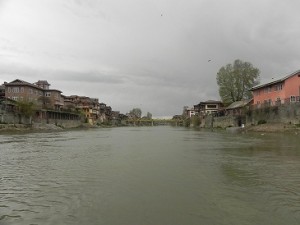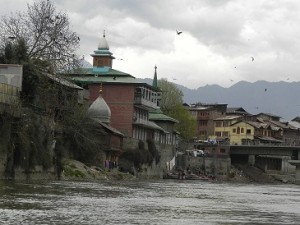Peace Watch » Editor's Take » My Nile Tells Stories of Agony and Ecstasy
My Nile Tells Stories of Agony and Ecstasy
It was an odyssey- a grand odyssey: ‘sailing along the past’ with the great Sultans of Kashmir, sharing pinnacles of their glories, celebrating their victories and tasting their benevolences. Singing hymns in chorus with the great saints of the yore and living mystic experiences with the great mystics of the land. Suffering with the multitudes fleeced alive by the beastly rulers and then hanged from the cantilever bridges like sheep from hooks in a butcher’s shop. The horrendous tales about bodies of men skinned alive filled with hay hanged from third bridge on the river for not paying taxes to the rulers who had purchased the country from British for paltry send to us shivers down the spine to us in our childhood.
On Saturday, when a tour operator friend organized a journey for a group of lovers of Kashmir heritage mostly my childhood peers on his cruise down and up the river Jhelum it was to use Leigh Hunt’s phrase ‘threading a dream’ and reliving the history. 
As the boat glided on the spring sparkling waters of our own Nile from the Pirzoo Island the ‘storied Veth’ started unfolding itself like that of Soma Deva’s Kathasarit sagara, with every page telling a story of our scintillating past punctured with sordid tales of brutalities and betrayals. The crumbling heritage buildings on the banks, with their faded signboards speaking about the glory of our arts and crafts also reminded me of the Wazir Punnus and Qudeh Lalas of the Zaldagar Maidan tragedy.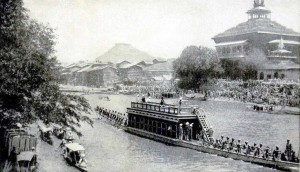
Scenes of the years gone by started rolling before my eyes. Some scenes of my childhood and childhood of a generation ahead of us have become oozing scars of our history. There are stories about women having jumped into the river for saving their honor from lascivious desperadoes that ruthlessly looted this land of its riches. As the boat sliced through the waters, most of us on the cruise remembered some historical river processions and regattas with all their grandeur’s. 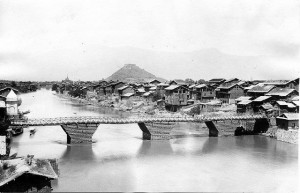
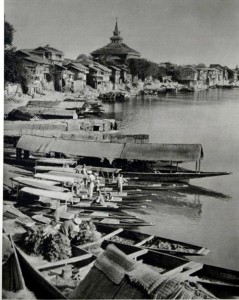
Market on Jehlum in olden times. In my childhood, I often heard stories from elders about the majesty of the royal river processions of the Maharajas. The stories about their magnificent ornately decorated boats rowed by hundreds of oarsmen in sparkling white often floated me in a world of imagination.
The river processions were not only a privilege of the royalty but these had been weaved intricately into the political narrative of the state. Many in our childhood remembered the river turning agog in October 1932,with hundreds of boats (Dongas) anchored on the banks of the river from third to fifth bridge on the Jhelum for housing delegates for the first session of the Jammu and Kashmir Muslim Conference. Green flags with white crescent in the middle were hoisted on these boats adorned with buntings. One of our neighbors, a copper-smith by profession often recounted his three days on the grounds of the Shahi-Masjid. He even remembered names of many delegates from distant places like Mirpur and Bhimber. There were many stories about the river procession and reception accorded to Jawaharlal Nehru and other leaders of All India Congress by the National Conference and protests and ugly scenes thereof.
While on the Cruise, reliving our history, I remembered the first river procession that I had witnessed as a child. I was barely six or seven years, perhaps in second primary in Government Middle School, Daribal. One fine morning all the children were conducted through small lanes to a nearby bank of the river barely a half mile from our school. Many boys carried multi-colored small flags in their hands. All that we knew was that a great boat pageant was to pass through the river and we had to greet the people in the boats with cheers and hip hip hooray that we pronounced as yup yup hurray . Most children cried full throat as the school bands played drums and flutes on the banks. .
It was years later that I learnt that it was a reception for top Russian leaders Nikolai Alexandrovich Bulganin and Nikita Sergeyevich Khrushchev and the date was first week of November 1955. And I learnt implication of this visit much later. I still remember having seen pictures of the Prime Minister of the State Bakshi Ghulam Muhammad sharing food from same plate with Bulganin in the shop of a tobacco seller Muhammad Kak in our Mohalla. I remember having seen pictures of some prominent Kashmir writers with these Russian leaders in the shop of the tobacco seller.
On top of his shop was the office of the National Conference..
Later, I had the opportunity of witnessing many a political processions passing through this river and last I think again was a reception of Mrs. Gandhi by Sheikh Abdullah in 1975 and to Neelam Sanjeeva Reddy President of India.
Filed under: Editor's Take · Tags: boat ride, bridges on jehlum, jehlum, Kashmir, kashmir bridges, peacewatch, shikara, Srinagar, Zahid G Muhmmad
